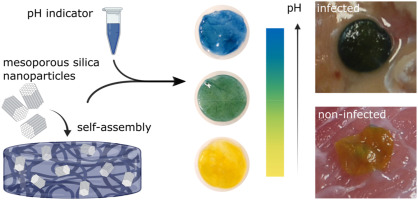Work package 3
Possibilities to both further improve the properties wound dressings is of large interest. The microenvironment in non-healing wounds is characterized by infection and biofilm formation, reduced angiogenesis, decrease in growth factors, and a self-sustaining proinflammatory response. Rapid and cost-effective technologies for assessing and predicting wound healing status can enable a more efficient and appropriate treatment, reducing healing time and overuse of antibiotics. Embedded sensors can provide direct feedback on the effect of the treatment and enable informed decisions on continued wound treatment, including need for antibiotics or antimicrobial dressings. With the objective to enable more quantitative and non-invasive wound diagnostics, studies in work package 3 aim to develop means to introduce sensor functionalities in dressings developed in work package 2.
Nanoplasmonic materials. Unique strategies to immobilize inorganic nanoparticles have been developed and optimized, with a focus on gold nanoparticles, in both BC and TEMPO-oxidized wood nanocellulose dressings. The work has been published in the journal Advanced Functional Materials:
Eskilson, O., Lindström, S. B., Sepulveda, B. et al. Self‐Assembly of Mechanoplasmonic Bacterial Cellulose–Metal Nanoparticle Composites. Advanced Functional Materials 2020, 30, 2004766
A method for patterning of NPs in dressings has been developed but not yet explored extensively. Based on gold nanoparticle functionalized BC dressings, we have designed a protease sensor that can detect common wound pathogens. The protease-responsive wound dressings display good results in vitro and can detect proteases secreted from common wound pathogens in complex sample matrixes. Evaluation of these functionalized dressings in infected ex vivo wound models is ongoing within work package 5.
pH responsive wound dressings. The strategy of immobilization of nanoparticles was extended to also function for mesoporous silica nanoparticles (MSNs). Large quantities of MSNs could be immobilized in the wound dressings. The MSNs were used as carriers for pH responsive dyes, that could report continuously on wound pH over a relevant range for early detection of wound infections- Whereas the pH of intact and non-infected skin is slightly acidic and typically varies between 4 and 6, the pH values of chronic wounds are typically in the range of pH 7–9. The high contrast of the dye that we used allowed for simple naked eye readout of wound pH, which will facilitate for patients or healthcare personal to diagnose infection at an early stage. The pH-responsive dressings have been extensively evaluated in vitro using primary dermal fibroblasts and keratinocytes, which tolerates the dressings. The in vivo function was evaluated using infected wounds in a porcine model. The work has been published in the journal Materials Today BIO:
Olof Eskilson, Elisa Zattarin, Linn Berglund et al. Nanocellulose composite wound dressings for real-time pH wound monitoring. Materials Today Bio, Volume 19, 2023,100574.

All HEALiX publications are found under “Publications” in the main menu.
Read more on the other work packages of HEALiX:
WP2 – Materials development and optimization
WP4 – Antimicrobial materials
WP5 – Preclinical validation
WP6 – Clinical validation
